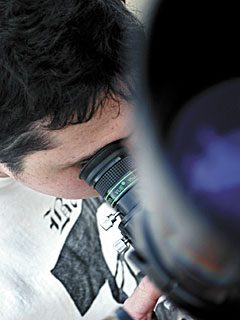 |
|
CLAIRE C. LAURENCE/Arizona Daily Wildcat
|
Physics and Astronomy freshman Alan Aversa was one of many stargazers set up on the UA Mall Saturday to celebrate the landing of NASA's probe on Titan, Saturn's largest moon, an endeavor involving many UA scientists.
|
|
|
By Lisa Rich
Arizona Daily Wildcat
Tuesday, January 18, 2005
Print this
The first surface images of Titan, Saturn's largest moon, were unveiled Saturday in the Kuiper Space Sciences building after the Huygens probe landed on the moon Friday.
Part of the Cassini spacecraft designed to photograph Saturn, the Huygen's probe is a device designed to allow an imaging system to detach from the spacecraft and successfully enter Titan's unpredictable atmosphere.
A projector screen was set up in a third-floor lecture hall of the Kuiper Space Sciences building to assist describing the history of the mission, details of the Descent Imager/Spectral Radiometer (DISR) photographing instrument and pictures of Titan.
More than 180 people crowded into the lecture hall for the discussion, with about 300 others standing in the atrium. Adults held children on their shoulders to see the atrium's projection screen, while others stood against railings on the fourth and fifth floors, looking down to the screen.
Virginia Smith, event coordinator, said although she expected a large audience, she was excited and surprised by the turnout.
"I didn't expect this," said Smith, a budget analyst for the Lunar and Planetary Laboratory. "I couldn't be happier."
Smith said the event required months of planning and heavily depended on the work of student volunteers.
Karis Jursen, an elementary education freshman and event volunteer, said she was happy to volunteer because the discovered information could have an impact on the future.
"It's pretty amazing to have the opportunity to do this now," Jursen said. "The information discovered now will have an impact on what we learn in the future."
Jursen was responsible for running events appropriate for students in fourth through ninth grade, including a liquid nitrogen demonstration. The demonstration simulated the environment present on Titan, she said.
Michael Drake, director of the Lunar and Planetary Laboratory, began the presentation with a brief description of the laboratory and the efforts that went into the mission to Titan.
"This was a lot of work," Drake said, "This was a human endeavor involving scientists, engineers and coordinators. I can't think of a better place for showing the results."
In order to retrieve new information, a camera able to photograph several aspects of the moon was needed, said Martin Tomasko, UA research professor and DISR principal investigator.
Tomasko said photographs of Titan were taken by the DISR, a three-part camera he designed, with three different lenses allowing for vertical and horizontal photographs.
Engineers from the Lockheed Martin Corporation, headquartered in Maryland, helped develop the instrument in the UA Lunar and Planetary Laboratory more than seven years ago, Tomasko said.
After completion, the DISR attached to the Huygens probe, which rode "piggy back" on the Cassini spacecraft, launched in 1997, Tomasko said.
"Why study Titan?" Tomasko said. "It's one of the most unique moons in our solar system. We're looking at a pre-biotic atmosphere like Earth's frozen in time."
Tomasko said from studying Titan, scientists could learn secrets to Earth's development.
Preliminary results show, like Earth, Titan has a significant nitrogen-based atmosphere. Data also shows Titan contains methane, hydrocarbons and amino acids, which are all substances required for primitive life, Tomasko said.
In addition, Tomasko said the photographs reveal clouds in the Southern region of the moon forming and evaporating and the photos also reveal "white trails," suggesting a methane ground fog exists.
Other results show evidence of a shoreline and fluid draining channels that may still contain liquid. Rocks on Titan's surface appear to be rounded, suggesting hydrocarbon or liquid flows once or still exist on Titan, Tomasko said.
Tomasko said photographs revealing a rocky surface and orange colored atmosphere are, "worth the entire Cassini mission," which cost about $3 billion and took 20 years of planning.
During and after the presentation, the Flandrau Science Center and Planetarium and Tucson Amateur Astronomy Association held a Star Party on the UA Mall in front of the Kuiper Space Sciences building.
Lines of people waited to take a peek through one of the 10 telescopes made available to the public, each focused on different space images such as sunspots, the Machholtz comet and Saturn in opposition, said Michael Terenzoni, astronomy coordinator of Flandrau.
Terenzoni said he was excited for the event and was pleased the university agreed to shut off the streetlights and sprinklers to avoid interfering with the telescopes.
